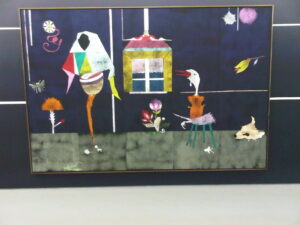
The twins have described their work as having an ‘opulence’, indeed, even the dusky-dark portraits look as though they could be salvage from a water-damaged old stately home. But the opulence is really in the magnificent stretches of woodcut canvases; an opulence of labour, of colour (which does not belong to paint, but to the richer otherworldly texture of printing), of patterned gold leaf and of the fabulous creatures of imagination and myth.
The sense of play is important. I watch a video interview on Youtube where the cutting of the footage deliberately distorts our ability to distinguish between the identical pair. There is no sense of their individuation; one twin works on the left of the studio, the other on the right. Like conspiring children, the Tobias Twins delight in the labyrinthine twists and turns of their own game.
It may not be immediately obvious, but the Tobias twins have even manipulated the gallery space; painting the walls a rich, magnificent blue, with white lines which divide woodcuts and picture frames.
In the collages new beings and unidentifiable narratives are created from the assemblage of kitschy cut-outs. There is a phantasmagoria of repeating imagery; duck beaks, bird heads, moths and other insects, pendulous limbs and heads. If there seems to be a plot to follow in the giant story boards of their woodcuts, the viewer is unable to trace it because of its disorientating unfamiliarity.
How delicious, for a pair of identical Transylvanian twins to make work about folklore and myth. Suddenly it is possible to believe in dark woods in the mountains of Brasov, Romania, where vampires live and little girls in red caps lure wolves back to their grandmothers. I desperately want to find a book of fairytales illustrated by Gert & Uwe Tobias at the end of the exhibition; perhaps it is this longing which is the lingering symptom of their art work. I want in on their world. No matter how nightmarishly atmospheric, there is an enchanting beauty beneath the surface.




Leave a Reply